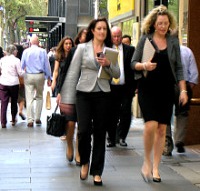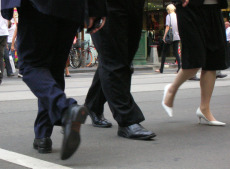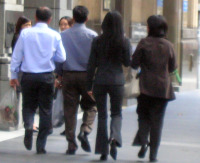Economic benefits

“The economic value of walking has been described as the walking economy. There is a direct link between the city’s economic prosperity and the safety and convenience of the pedestrian experience.”
(City of Melbourne 2012)
The Federal Government final policy paper Walking, Riding and Access to Public Transport provides a reasonable overview of the economic benefits of walking and cycling. This suggests that the majority of the broad economic benefits of walking derive from the health benefits and associated reduction in medical costs. However there is considerable evidence of the direct benefits of walkable environments to local economies and business.
In November 2010, the National Heart Foundation of Australia released the report Good for Busine$$, which looks at case studies from around the world that show the increased business and vitality that catering for pedestrians provides.
Various studies have identified that walking is a more important mode of travel to shopping, and car travel is less important, than is typically perceived by retailers. For example, a study in Graz, Austria, found that retailers thought 58% of their customers drove to the shop and 25% walked, but in fact only 32% drove and 44% walked (Sustrans 2006). The case studies below illustrate similar results for Melbourne. Business respondents in High Street Northcote overestimated the proportion of people who drove and dramatically underestimated the proportion who walked (17% compared to an actual 36%).
Walkability and land value

Significantly, there is evidence to suggest that better walkability adds substantial value not only to retail property but also to office and residential property.
A study of more than 4,200 properties in the United States found properties with a Walk Score of 80 were worth anywhere from 6 to 54 per cent more than properties with a 20 Walk Score, depending on property type. Consistent with their higher values, the study also also found higher net operating incomes for the office and retail properties (Pivo and Fisher 2010). Similar results have been found in a comprehensive study of walkability and economic performance in Washington DC, even after adjustment for household income (see our news story on Leinberger and Alfonzo 2012).
The evidence for higher land value in walkable areas is consistent with Melbourne, where the areas with the highest levels of walking - inner suburbs - have the highest property values.
Walking and the knowledge economy

The evidence that walkability adds to land value is consistent with the evidence on agglomeration economies – the spatial concentration of economic activity that leads to greater productivity (Donovan and Munro 2013). Some studies suggest that the emergence of the knowledge economy has strengthened the significance of agglomeration economies. There is also evidence that agglomeration economies are most significant within, or in some cases even exclusive to, walkable catchments (Arzaghi and Henderson 2008).
The apparently broad economic value of walkability is likely to be related to travel efficiencies over short distances. Walking is generally the fastest means of travel for trips of up to 400 metres (Australian Government 2012). It follows that creating the conditions to shift these short trips from cars to walking will improve the overall efficiency of the economy.
Cities need to be walkable to provide an attractive lifestyle to existing and prospective residents. The American report What do the Best Entrepreneurs Want in a City? outlines the critical role of lifestyle in attracting the entrepreneurs that establish fast growing businesses.
"Walkable environments should be viewed as economic infrastructure that attract employment and should be invested in accordingly." (Paul Shaker, Plan Canada, Fall 2012)